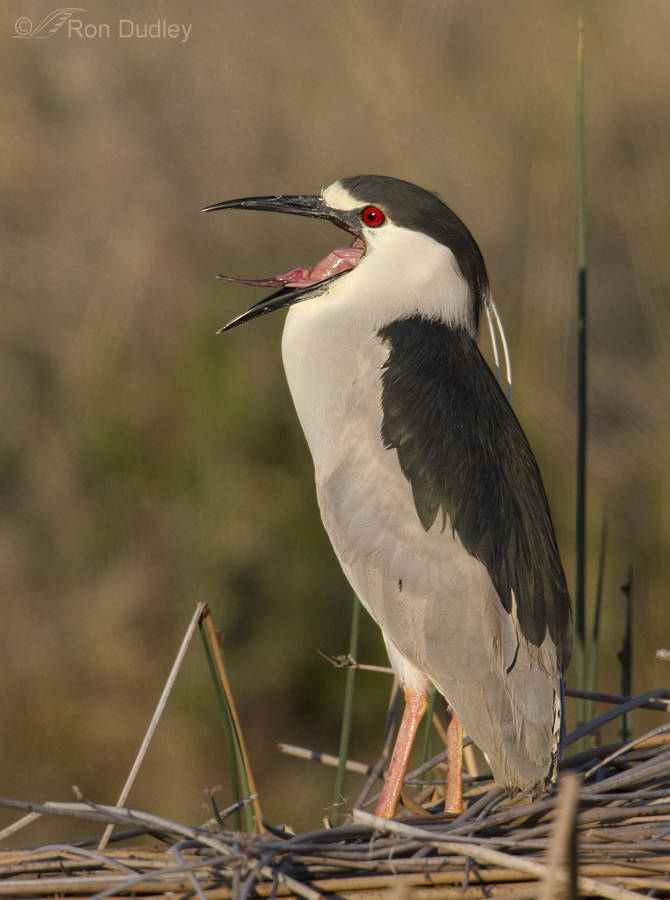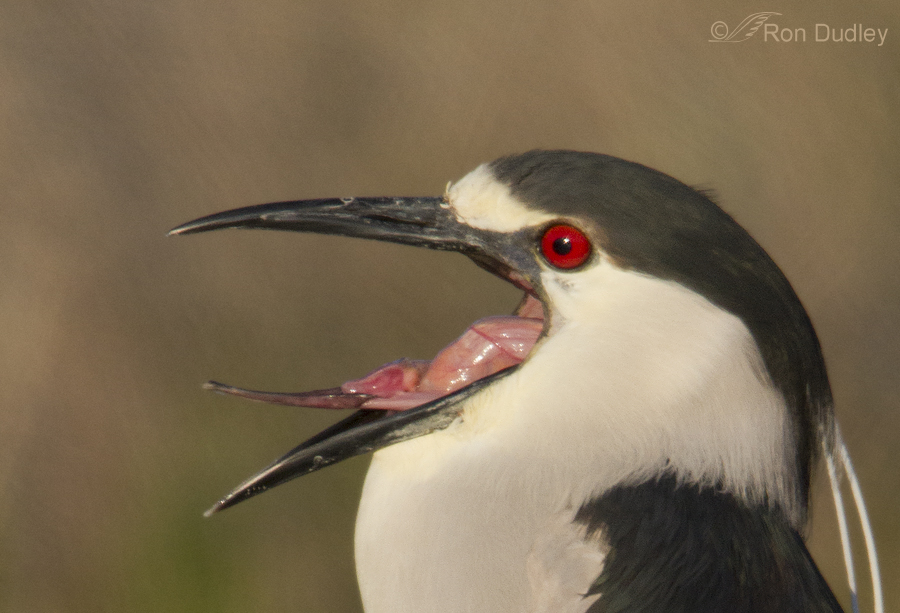The Black-crowned Night Heron is the most widespread heron in the world. They are opportunistic feeders that feed on a wide variety of prey and I’ve seen them swallow some amazingly large prey items. I suspect that their rather interesting-looking tongue plays a significant role in their success.
1/2000, f/7.1, ISO 500, 500 f/4, 1.4 tc, natural light
This heron (there’s an insect on its wing) let me get relatively close and eventually gave me an enthusiastic yawn that revealed its bi-colored, knobby looking tongue. I’ve seen these birds swallow fish that were seemingly large enough to “choke a horse” and the interesting anatomy of its tongue may contribute to that ability.
A heavy crop gives a somewhat better look. The front, darker colored part of the tongue fits perfectly into the groove of the lower mandible and seems to have a slight knob at the tip. The more proximal third of the tongue is much lighter colored and seems to be separated from the front portion of the organ by a noticeable groove. And then there’s those protuberances (for lack of a better term) at top, also bicolored, that I suspect may be able to be raised during the swallowing process to help force food down the throat (I’m only guessing on that one).
I spent some time attempting to research the anatomy and function of their rather unique-looking tongue but came up mostly empty. I wish I knew more…
Ron




All I know about this bird is that I fed it part of a french fry at seaworld in CA. I turned my head after putting horseradish on my roast beef sandwich and this red-eyed opportunist took my sandwich off the table and dropped it on the pavement. I was so mad — I did not even get one bite (I did not intend to feed it a $10 sandwich). I did notice, however, that as the bird gulped down my roast beef, it shook its head back and forth and large amounts of water or saliva sprayed from its mouth each time it went back for more and shook its head. My husband thinks the bird may have been spraying saliva because it disliked the horseradish, but I disagree because it kept going back for more.
As this photo and Maria Firpi’s excellent GBHE photo shows, and William Dove has stated, bird tongues are a marvel of design. The glottis is right at the base and easily seen in many species (some of the thick tongued birds, like pigeons and some ducks make that a bit harder) – which makes it easy for a rehabilitator to gavage (tube) them; much more easily than with mammals, where you cannot see the glottis and trying to tube them is much riskier, as you don’t want to drown them by sending the tube into their lungs! This is a decided advantage when receiving a debilitated or shocky bird, as it can be very difficult in such cases to get into their small peripheral veins for IV fluids. Fluids are critical (think ER and IV drips), and oral fluids are thus less invasive and easier to deliver; if we can’t do oral (e.g., blood in the mouth), we have to do sub-cutaneous fluids (only a couple of places in a bird where you don’t risk going into an airsac, which can also drown them), or have to go into their hollow bones (intraosseous), for which we need to anesthetize them, which has risks of its own. [Probably way more information than anyone wants! Sorry!] Raptors, like the GBHE in Maria’s photo, have those boney ‘horns’ on the inside end which serve, as I understand it, to help send chunks of prey or whole prey items down the throat. I can’t tell if the BCNH has the same boney horns on the inside end of the tongue; it looks like it might but that they are lying down.
Fascinating information.
“Probably way more information than anyone wants! Sorry!”
You’re not often wrong but you are with that statement, Louise. I eat this stuff up and I’m pretty darn sure others do too. Thank you!
I agree, Ron!
Here are some examples of the glottis from various raptors. You can also see the tongue shape with the horns Louise mentioned that aid in the swallowing progress. BTW this link is to perhaps on the the best falconry information sites on the Internet:
http://www.themodernapprentice.com/trachea.htm
http://www.themodernapprentice.com
Lydia is a former client of my kennel and works for Microsoft and the creator of that excellent site.
I totally agree with what you have said about Lydia’s site, William. It’s uber-cmplete and useful (down to photos of healthy and unhealthy droppings!) Love it.
Louise: I think all here would find it interesting, very informative. If you are a falconer, on the fence about falconry, a rehabber or just interested in raptors.
Bill
William: thanks so much for sharing these amazing images and links. I could really see that glottis up-close.
I do look forward to clicking on your posts to find out what I’m going to learn today! Gulls have interesting tongues too, and their gape seems incredible sometimes. I hope to see one of these birds early next year, so will try to pay attention to their bill if I get the chance.
What a stunning bird – and how nice to hear that, with the help of its tongue, its ‘eyes are not bigger than its stomach’. A phrase my father levelled at the greedy, and those who had ‘bitten off more than they could chew’.
I’ve photographed some of these tongues and have been told they also have a hole in the middle of the tongue which is like a ‘windpipe’ or trachea opening; but have not been able to research this any further. It must be in a zoology journal not accessible to the public.
Maria, I saw one of your heron tongue images when I was doing my research. I’m aware of the opening you refer to – it’s called the glottis and its placement at the base of the tongue allows them to continue to breathe while swallowing large prey items.
Numerous bird species have a glottis, including all raptors.
Bill
Thanks for explaining this, Ron. If you look at the new index I added one more post of these set of images. They’re old already but depict the tongue with clarity.
http://www.caribbeanbiodiversity.com/2012/08/inside-great-blue-herons-tongue.html
I achieved this with fill-in flash at 400mm (too far to disturb the bird), and thanks to the fill-in I filled in all the shadows which would have ruined the shot.
Louise: thanks for the compliments.
Incredible shots Ron! Thanks for sharing.
Charlotte
Thanks, Charlotte.
Astonishing! I’m looking forward to comments from your viewers which may add details to ‘anatomy and function’.
Me too, Janet.
I don’t know much about the tongue of the various Heron species but do know some have had crabs crab their tongue and then been consummed by the Heron and that numerous Heron species bait their prey which include vegitation, fish, crustasiuns, birds and small mammals.
Bill
Bill, The BCNH is one of those heron species that has been documented to bait prey.
yes, along with GBH, SH, GH, LE another example of birds planning lol
Bill
WOW!!!
Ellen, that tongue got my attention, too.
Outstanding shot….!
Thanks, Bill.
…and look at those bright red eyes!
Great shot!
Those eyes do get your attention, don’t they, Nancy?